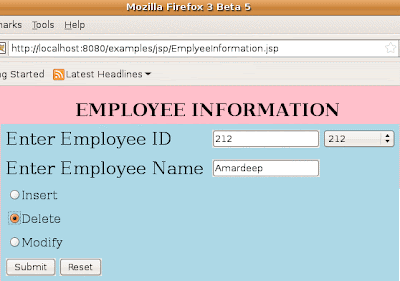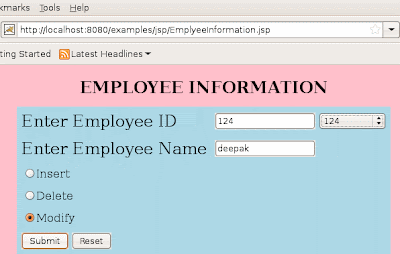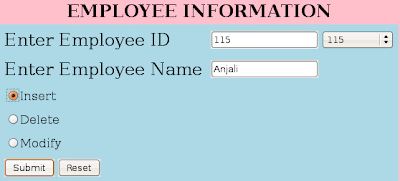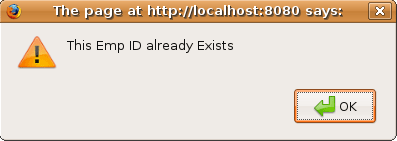Java Server Pages
JavaServer Pages (JSP) technology is the Java platform technology for delivering dynamic content to web clients in a portable, secure and well-defined way. The JavaServer Pages specification extends the Java Servlet API to provide web application developers
with a robust framework for creating dynamic web content on the server using HTML, and XML templates, and Java code, which is secure, fast, and independent of server platforms. JSP has been built on top of the Servlet API and utilizes Servlet semantics. JSP has become the preferred request handler and response mechanism. Although JSP technology is going to be a powerful successor to basic Servlets, they have an evolutionary relationship and can be used in a cooperative and complementary manner.
Servlets are powerful and sometimes they are a bit cumbersome when it comes to generating complex HTML. Most servlets contain a little code that handles application logic and a lot more code that handles output formatting. This can make it difficult to separate and reuse portions of the code when a different output format is needed. For these reasons, web application developers turn towards JSP as their preferred servlet environment.
Evolution of Web Applications
Over the last few years, web server applications have evolved from static to dynamic applications. This evolution became necessary due to some deficiencies in earlier web site design. For example, to put more of business processes on the web, whether in business-to-consumer (B2C) or business-to-business (B2B) markets, conventional web site design technologies are not enough. The main issues, every developer faces when developing web applications, are:
1. Scalability - a successful site will have more users and as the number of users is increasing fastly, the web applications have to scale correspondingly.
2. Integration of data and business logic - the web is just another way to conduct business, and so it should be able to use the same middle-tier and data-access code.
3. Manageability - web sites just keep getting bigger and we need some viable mechanism to manage the ever-increasing content and its interaction with business systems.
4. Personalization - adding a personal touch to the web page becomes an essential factor to keep our customer coming back again. Knowing their preferences, allowing them to configure the information they view, remembering their past transactions or frequent search keywords are all important in providing feedback and interaction from what is otherwise a fairly one-sided conversation.
Apart from these general needs for a business-oriented web site, the necessity for new technologies to create robust, dynamic and compact server-side web applications has been realized. The main characteristics of today's dynamic web server applications are as follows:
1. Serve HTML and XML, and stream data to the web client
2. Separate presentation, logic and data
3. Interface to databases, other Java applications, CORBA, directory and mail services
4. Make use of application server middleware to provide transactional support.
5. Track client sessions
Now let us have a look on the role of Java technology and platform in this regard.
Java's Role for Server Applications
Sun Microsystems, having consulted many expert partners from other related IT industries, has come out with a number of open APIs for the technologies and services on server side. This collection of APIs is named as Java 2 Enterprise Edition (J2EE). The J2EE specification provides a platform for enterprise applications, with full API support for enterprise code and guarantees of portability between server implementations. Also it brings a clear division between code which deals with presentation, business logic and data.
The J2EE specification meets the needs of web applications because it provides:
1. Rich interaction with a web server via servlets and built-in support for sessions available in both servlets and EJBs.
2. The use of EJBs to mirror the user interaction with data by providing automatic session and transaction support to EJBs operating in the EJB server.
3. Entity EJBs to represent data as an object and seamless integration with the Java data access APIs
4. Flexible template-based output using JSP and XML
This family of APIs mean that the final web page can be generated from a user input request, which was processed by a servlet or JSP and a session EJB, which represents the user's session with the server, using data extracted from a database and put into an entity EJB. Thus, the Java revolution of portable code and open APIs is married with an evolution in existing products such as database, application, mail and web servers. The wide availability of products to run Java applications on the server has made this a fast-moving and very competitive market, but the essential compatibility through specifications, standard APIs and class libraries has held. This makes server-side Java a very exciting area.
JavaServer Pages - An Overview
The JavaServer Pages 1.2 specification provides web developers with a framework to build applications containing dynamic web content such as HTML, DHTML, XHTML and XML. A JSP page is a text based document containing static HTML and dynamic actions which describe how to process a response to the client in a more powerful and flexible manner. Most of a JSP file is plain HTML but it also has, interspersed with it, special JSP tags.
There are many JSP tags such as:
* JSP directive denoted by <%@,
2. scriplets indicated by <% ... %> tags and
* directive includes the contents of the file sample.html in the response at that point.
To process a JSP file, we need a JSP engine that can be connected with a web server or can be accommodated inside a web server. Firstly when a web browser seeks a JSP file through an URL from the web server, the web server recognizes the .jsp file extension in the URL requested by the browser and understands that the requested resource is a JavaServer Page. Then the web server passes the request to the JSP engine. The JSP page is then translated into a Java class, which is then compiled into a servlet.
This translation and compilation phase occurs only when the JSP file is requested for the first time, or if it undergoes any changes to the extent of getting retranslated and recompiled. For each additional request of the JSP page thereafter, the request directly goes to the servlet byte code, which is already in memory. Thus when a request comes for a servlet, an init() method is called when the Servlet is first loaded into the virtual machine, to perform any global initialization that every request of the servlet will need. Then the individual requests are sent to a service() method, where the response is put together. The servlet creates a new thread to run service() method for each request. The request from the browser is converted into a Java object of type HttpServletRequest, which is passed to the Servlet along with an HttpServletResponse object that is used to send the response back to the browser. The servlet code performs the operations specified by the JSP elements in the .jsp file.
The Components of JSPs
JSP syntax is almost similar to XML syntax. The following general rules are applicable to all JSP tags.
1. Tags have either a start tag with optional attributes, an optional body, and a matching end tag or they have an empty tag possibly with attributes.
2. Attribute values in the tag always appear quoted. The special strings ' and " can be used if quotes are a part of the attribute value itself.
Any whitespace within the body text of a document is not significant, but is preserved, which means that any whitespace in the JSP being translated is read and preserved during translation into a servlet.
The character \ can be used as an escape character in a tag, for instance, to use the % character, \% can be used.
JavaServer Pages are text files that combine standard HTML and new scripting tags. JSPs look like HTML, but they get compiled into Java servlets the first time they are invoked. The resulting servlet is a combination of HTML from the JSP file and embedded dynamic content specified by the new tags. Everything in a JSP page can be divided into two categories:
1. Elements that are processed on the server
2. Template data or everything other than elements, that the engine processing the JSP engines.
Element data or that part of the JSP which is processed on the server, can be classified into the following categories:
1. Directives
2. Scripting elements
3. Standard actions
JSP directives serve as messages to the JSP container from the JSP. They are used to set global values such as class declaration, methods to be implemented, output content type, etc. They do not produce any output to the client. All directives have scope of the entire JSP file. That is, a directive affects the whole JSP file, and only that JSP file. Directives are characterized by the @ character within the tag and the general syntax is:
The three directives are page, include and taglib.
Scripting elements are used to include scripting code (Java code) within the JSP. They allow to declare variables and methods, include arbitrary scripting code and evaluate an expression. The three types of scripting element are: Declaration, Scriptlets and Expressions.
A declaration is a block of Java code in a JSP that is used to define class-wide variables and methods in the generated class file. Declarations are initialized when the JSP page is initialized and have class scope. Anything defined in a declaration is available throughout the JSP, to other declarations, expressions or code.
A scriptlet consists of one or more valid Java statements. A scriptlet is a block of Java code that is executed at request-processing time. A scriptlet is enclosed between "<%" and "%>". What the scriptlet actually does depends on the code, and it can produce output into the output stream to the client. Multiple scriptlets are combined in the compiled class in the order in which they appear in the JSP. Scriptlets like any other Java code block or method, can modify objects inside them as a result of method invocations.
An expression is a shorthand notation for a scriptlet that outputs a value in the response stream back to the client. When the expression is evaluated, the result is converted to a string and displayed, An expression is enclosed within <%= and %> "<%=" and "%>". If any part of expression is an object, the conversion is done using the toString() method of the object.
Standard actions are specific tags that affect the runtime behavior of the JSP and affect the response sent back to the client. The JSP specification lists some standard action types to be provided by all containers, irrespective of the implementation. Standard actions provide page authors with some basic functionality to exploit; the vendor is free to provide other actions to enhance behavior.
How JSP and JSP Container function
A JSP page is executed in a JSP container or a JSP engine, which is installed in a web server or in a application server. When a client asks for a JSP page the engine wraps up the request and delivers it to the JSP page along with a response object. The JSP page processes the request and modifies the response object to incorporate the communication with the client. The container or the engine, on getting the response, wraps up the responses from the JSP page and delivers it to the client. The underlying layer for a JSP is actually a servlet implementation. The abstractions of the request and response are the same as the ServletRequest and ServletResponse respectively. If the protocol used is HTTP, then the corresponding objects are HttpServletRequest and HttpServletResponse.
The first time the engine intercepts a request for a JSP, it compiles this translation unit (the JSP page and other dependent files) into a class file that implements the servlet protocol. If the dependent files are other JSPs they are compiled into their own classes. The servlet class generated at the end of the translation process must extend a superclass that is either
1. specified by the JSP author through the use of the extends attribute in the page directive or
2. is a JSP container specific implementation class that implements javax.servlet.jsp.JspPage interface and provides some basic page specific behavior.
Since most JSP pages use HTTP, their implementation classes must actually implement the javax.servlet.jsp.HttpJspPage interface, which is a sub interface of javax.servlet.jsp.JspPage.
The javax.servlet.jsp.JspPage interface contains two methods:
1. public void jspInit() - This method is invoked when the JSP is initialized and the page authors are free to provide initialization of the JSP by implementing this method in their JSPs.
2. public void jspDestroy() - This method is invoked when the JSP is about to be destroyed by the container. Similar to above, page authors can provide their own implementation.
The javax.servlet.jsp.HttpJspPage interface contains one method:
public void _jspService(HttpServletRequest request, HttpServletResponse response) throws ServletException, IOException
This method generated by the JSP container is invoked, every time a request comes to the JSP. The request is processed and the JSP generates appropriate response. This response is taken by the container and passed back to the client.
JSP Architecture
There are two basic ways of using the JSP technology. They are the client/server (page-centric) 2-tier approach and the N-tier approach (dispatcher).
The Page-Centric Approach
Applications built using a client-server (2-tier) approach consist of one or more application programs running on client machines and connecting to a server-based application to work. With the arrival of Servlets technology, 2-tier applications could also be developed using Java programming language. This model allows JSPs or Servlets direct access to some resource such as database or legacy application to service a client's request. The JSP page is where the incoming request is intercepted, processed and the response sent back to the client. JSPs differ from Servlets in this scenario by providing clean code, separating code from the content by placing data access in EJBs. Even though this model makes application development easier, it does not scale up well for a large number of simultaneous clients as it entails a significant amount of request processing to be performed and each request must establish or share a potentially scarce/expensive connection to the resource in question.
Page-view - This basic architecture involves direct request invocations to a server page with embedded Java code, and markup tags which dynamically generate output for substitution within the HTML. This approach has been blessed a number of benefits. It is very straightforward and is a low-overhead approach from a developerment perspective. All the Java code may be embedded within the HTML, so changes are confined to a very limited area, reducing complexity drastically.
The big trade-off here is in the level of sophistication. As the scale of the system grows, some limitations begin to surface, such as bloating of business logic code in the page instead of factoring forward to a mediating Servlet or factoring back to a worker bean. It is a fact that utilizing a Servlet and helper beans helps to separate developer roles more cleanly and improves the potential for code reuse.
Page-view with bean - This pattern is used when the above architecture becomes too cluttered with business-related code and data access code. The Java code representing the business logic and simple data storage implementation in the previous model moves from the JSP to the JavaBean worker. This refactoring leaves a much cleaner JSP with limited Java code, which can be comfortably owned by an individual in a web-production role, since it encapsulates mostly markup tags.
The Dispatcher Approach
In this approach, a Servlet or JSP acts as a mediator or controller, delegating requests to JSP pages and JavaBeans. There are three different architectures. They are mediator-view, mediator-composite view and service to workers.
In an N-tier application, the server side of the architecture is broken up into multiple tiers. In this case, the application is composed of multiple tiers, where the middle tier, the JSP, interacts with the back end resources via another object or EJBs component. The Enterprise JavaBeans server and the EJB provide managed access to resources, support transactions and access to underlying security mechanisms, thus addressing the resource sharing and performance issues of the 2-tier approach.
The first step in N-tiered application design should be identifying the correct objects and their interaction and the second step is identifying the JSPs or Servlets. These are divided into two categories.
Front end JSPs or Servlets manage application flow and business logic evaluation. They act as a point to intercept the HTTP requests coming from the users. They provide a single entry point to an application, simplifying security management and making application state easier to maintain.
Presentation JSPs or Servlets generate HTML or XML with their main purpose in life being presentation of dynamic content. They contain only presentation and rendering logic.
These categories resemble to the Modal-View design pattern, where the front-end components is the model and the presentation component the view. In this approach, JSPs are used to generate the presentation layer and either JSPs or Servlets to perform process-intensive tasks. The front-end component acts as the controller and is in charge of the request processing and the creation of any beans or objects used by the presentation JSP, as well as deciding, depending on the user's actions, which JSP to forward this request to. There is no processing logic within the presentation JSP itself and it simply responsible for retrieving any objects or beans that may have been previously created by the Servlet and extracting the dynamic content for insertion within static templates.
Benefits of JSP
One of the main reasons why the JavaServer Pages technology has evolved into what it is today and it is still evolving is the overwhelming technical need to simplify application design by separating dynamic content from static template display data. Another benefit of utilizing JSP is that it allows to more cleanly separate the roles of web application/HTML designer from a software developer. The JSP technology is blessed with a number of exciting benefits, which are chronicled as follows:
1. The JSP technology is platform independent, in its dynamic web pages, its web servers, and its underlying server components. That is, JSP pages perform perfectly without any hassle on any platform, run on any web server, and web-enabled application server. The JSP pages can be accessed from any web server.
2. The JSP technology emphasizes the use of reusable components. These components can be combined or manipulated towards developing more purposeful components and page design. This definitely reduces development time apart from the At development time, JSPs are very different from Servlets, however, they are precompiled into Servlets at run time and executed by a JSP engine which is installed on a Web-enabled application server such as BEA WebLogic and IBM WebSphere.
Conclusion
JSP and Servlets are gaining rapid acceptance as means to provide dynamic content on the Internet. With full access to the Java platform, running from the server in a secure manner, the application possibilities are almost limitless. When JSPs are used with Enterprise JavaBeans technology, e-commerce and database resources can be further enhanced to meet an enterprise's needs for web applications providing secure transactions in an open platform. J2EE technology as a whole makes it easy to develop, deploy and use web server applications instead of mingling with other technologies such as CGI and ASP. There are many tools for facilitating quick web software development and to easily convert existing server-side technologies to JSP and Servlets.
Many application server vendors are aggressively deploying JSP within their products. This results in developing robust e-commerce applications as JSP provides XML functionality and scalability. By providing a clear separation between content and coding, JSP solves many problems attached with existing server-side applications.









